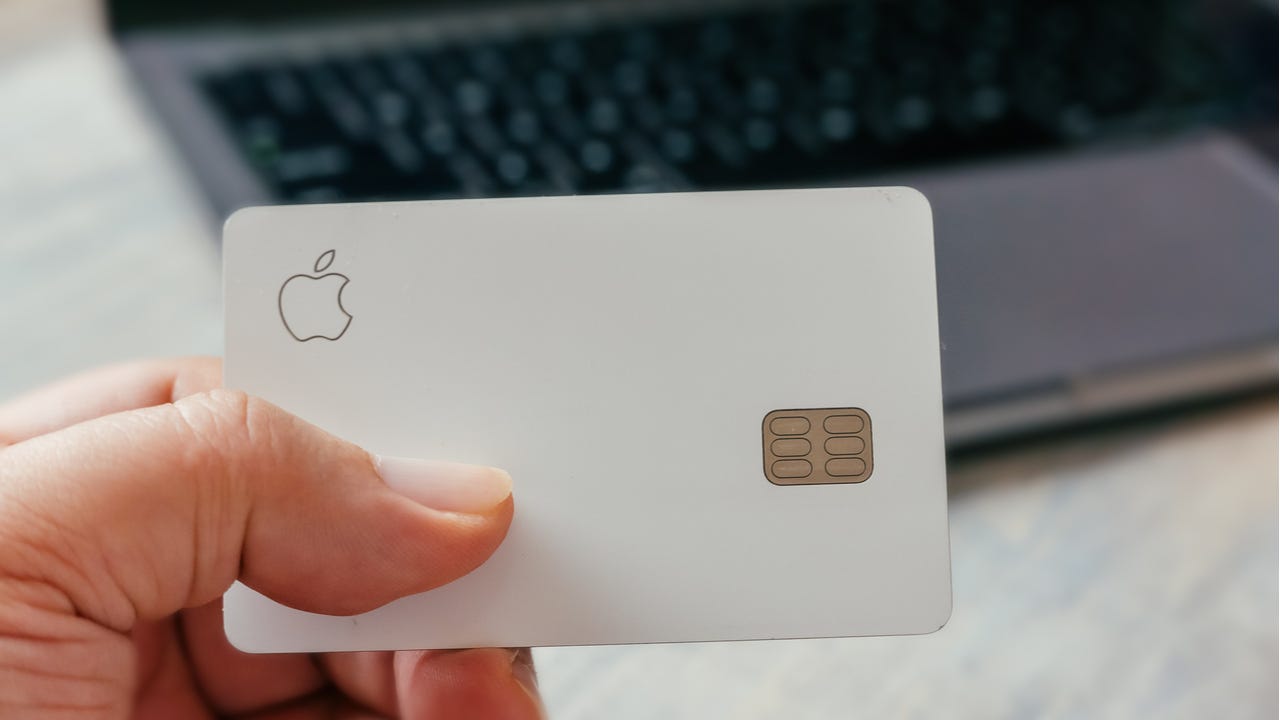Can you pay off your Apple Card with a balance transfer?

The Bankrate promise
At Bankrate we strive to help you make smarter financial decisions. While we adhere to strict , this post may contain references to products from our partners. Here's an explanation for . The content on this page is accurate as of the posting date; however, some of the offers mentioned may have expired. Terms apply to the offers listed on this page. Any opinions, analyses, reviews or recommendations expressed in this article are those of the author’s alone, and have not been reviewed, approved or otherwise endorsed by any card issuer.
Key takeaways
- There's more than one way to pay off an Apple Card, including online payments or recurring and one-time payments.
- However, the Apple Card doesn't allow for balance transfers to the card, and it doesn't appear to let consumers transfer their Apple Card balances to other balance transfer cards either.
It’s easy to see why the Apple Card is so popular. Cardholders don’t pay an annual fee, foreign transaction fees or any late fees, but still have the chance to earn an unlimited 3 percent cash back on purchases with select merchants that let you pay with your Apple Card and Apple Pay, as well on goods and services purchased directly from Apple. Cardholders also receive 2 percent back anywhere Apple Pay is accepted, as well as 1 percent back on all other purchases.
And there’s more than one way to pay off an Apple Card, including online payments or recurring or one-time payments in your device’s Wallet app. If your device is missing or stolen, you can call an Apple Card specialist to avoid missing a payment.
But when you dive into the Apple Card’s terms and conditions from Goldman Sachs, you’ll notice one interesting omission: The Apple Card doesn’t have a balance transfer APR or a balance transfer fee — and for good reason. This card doesn’t allow balance transfers at all.
What’s also interesting is that the Apple Card doesn’t appear to let consumers transfer their Apple Card balances to other balance transfer cards either. Here’s what to know if you’re wondering how to pay off an Apple Card with a balance transfer but you keep running into roadblocks.
Can you transfer a balance from the Apple Card to another credit card?
No, the Apple Card does not appear to support balance transfers. Cardholder reports vary, but you can read real user experiences in places like the myFICO forum and Reddit.
It appears to come down to what Apple considers “non-conforming payments.” Here’s what Apple says about payments it considers to be non-conforming in its cardholder agreement:
“We may reject any payments that do not comply with our payment instructions set forth in this Agreement or on your Monthly Statement (each a ‘Non-conforming Payment’) in our discretion. If we accept a Non-conforming Payment, crediting your Account for the payment may be delayed and may result in additional interest billed to your Account.”
Apple also says:
“We may accept any Non-conforming Payments, late payments, partial payments or payments with restrictive endorsements, without losing any of our rights, including our right to close your Account. We may deposit any payment you send us for less than the total outstanding balance of your Account that you mark ‘paid in full’ or with any similar language or otherwise seek to provide as full satisfaction of a disputed amount. If we do, this payment will not fully satisfy the disputed amount or otherwise affect our rights to payment in full.”
That said, Apple reserves the right not to accept any balance transfers to and from the Apple Card. It’s only required to accept a payment method that it has outlined, such as submitting online payments, paying through the Wallet app or by talking to an Apple specialist.
If Apple does accept a payment method that isn’t listed as an option to cardholders, there’s a possibility it could close the account. Even if a payment is sent and marked “paid in full,” it doesn’t mean Apple will accept the transfer. Rather, the issuer reserves the right to still pursue full repayment.
With this in mind, you should take care to avoid racking up debt on your Apple Card unless you have a plan to pay it off. Otherwise, you may have to turn to debt consolidation alternatives to get out of this debt later on.
Alternative ways to pay off your Apple Card
Ultimately, Apple does not control how you pay off your balance with its credit card. If you have debt on an Apple Card you would prefer to consolidate, here are workarounds to consider.
Write a balance transfer check to yourself
While you may not be able to sign up for a balance transfer card and transfer your Apple Card balance the traditional way, balance transfer checks can help you transfer your balance with a few more steps. When you’re approved for a balance transfer credit card that offers balance transfer checks, you have the option to complete a check paid to yourself. With this strategy, you can write yourself a check for the amount of debt you want to consolidate from your Apple Card, and then simply pay off the balance on your Apple Card using the same funds.
Keep in mind that even the best balance transfer credit cards charge a balance transfer fee that’s 3 percent to 5 percent of the debt you transfer. This fee kicks in on any balance transfer checks you write to yourself, adding 3 percent or 5 percent to the new amount you owe.
That said, make sure you choose a balance transfer credit card that offers a 0 percent APR for as long as possible. Your interest savings will make paying the balance transfer fee well worth it.
Take out a debt consolidation loan
You can also consider consolidating debt with a personal loan, which may make it easier to avoid racking up more debt. Personal loans come with a low fixed interest rate, a fixed monthly payment and a fixed repayment timeline, so you know exactly when you’ll pay your debt off.
When you take out a personal loan, you get the amount you borrow as a lump sum of cash upfront. When you deposit your loan proceeds in your bank account, you can use the money to pay off your Apple Card and begin making payments on your loan.
Before borrowing money, compare personal loans to find the best option for your needs and your budget. Personal loan rates can be as low as 10.3 percent for consumers with great credit, and many personal loans come with no application fees, no origination fees and no hidden fees.
Apply for the Upgrade Cash Rewards Visa®
You can also consider a unique lending instrument like the Upgrade Cash Rewards Visa®. This debt consolidation credit card works more like a traditional loan, and you may qualify for a line of credit worth up to $25,000*. While you can’t transfer balances directly to this card, you can make a draw against your available credit and then use those funds to pay off your Apple Card.
The Upgrade Cash Rewards doesn’t charge any fees, and it comes with a mobile app that lets you monitor your balances and purchases in real time. You can pay less interest over time than you might with traditional credit cards, since the Upgrade Cash Rewards lets you pay down your balances each month at a fixed rate with equal monthly payments.
The bottom line
If you’re feeling frustrated that you can’t pay off your Apple Card how you want to, you have a few workarounds to consider. However, you may want to start thinking more long term about the Apple Card — and perhaps even transition to another card for your everyday spending.
The Apple Card does offer lucrative rewards when you use it to complete purchases through Apple Pay, but plenty of other starter credit cards will let you manage your debt the way you want — and without all the red tape.
*Credit Lines opened through Upgrade feature Annual Percentage Rates (APRs) of 14.99% – 29.99% and line amounts ranging $500 – $25,000. Optional ACH transfers to your bank account, balance transfers, and foreign transactions are subject to fees that, if incurred, will increase your finance charge and APR. The lowest rates require Autopay and the majority of the line amounts will be $15,000 or under. For example, a $5,000 transaction with a 36 month term and a 19.99% APR has a required monthly payment of $187.90. The APR on your transaction may be higher or lower. Your rate, line amount, and default term depend on maintaining a qualifying credit score, your credit usage history, requested amount, and other factors. The Upgrade Card is unique in that it allows you to obtain a series of closed-end loans which you may access through transactions such as card purchases up to the approved line amount. As you repay your balance, additional credit may become available to you up to the approved line amount subject to meeting our credit requirements. The Upgrade Card will not replenish as it would in an open-end credit arrangement.
Related Articles



